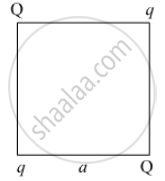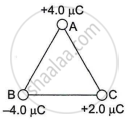Advertisements
Advertisements
Question
Calculate potential energy of a point charge – q placed along the axis due to a charge +Q uniformly distributed along a ring of radius R. Sketch P.E. as a function of axial distance z from the centre of the ring. Looking at graph, can you see what would happen if – q is displaced slightly from the centre of the ring (along the axis)?
Solution
The potential energy (U) of a point charge q placed at-potential V, U = qV In our case a negative charged particle is placed at the axis of a ring having charge Q. Let the ring has radius a, the electric potential at an axial distance z from the centre of the ring is
`V = 1/(4piε_0) Q/sqrt(z^2 + a^2)`
Hence potential energy of a point charge – q is
`U = qV = (-q)[1/(4piε_0) Q/sqrt(z^2 + a^2)]`
⇒ `U = - 1/(4piε_0) (Qq)/sqrt(z^2 + a^2) = 1/(4piε_0) (-Qq)/sqrt(1 + (z/a)^2`
At z = 0, U = `- 1/(4piε_0) (Qq)/a`
At z → `oo`, U → 0

The variation of potential energy with z is shown in the figure. The charge – q displaced would perform oscillations. Nothing can be concluded just by looking at the graph.
APPEARS IN
RELATED QUESTIONS
A cube of side b has a charge q at each of its vertices. Determine the potential and electric field due to this charge array at the centre of the cube.
Four point charges Q, q, Q and q are placed at the corners of a square of side 'a' as shown in the figure.

Find the
1) resultant electric force on a charge Q, and
2) potential energy of this system.
Find out the amount of the work done to separate the charges at infinite distance.
A point charge Q is placed at point 'O' as shown in the figure. Is the potential at point A, i.e. VA, greater, smaller or equal to potential, VB, at point B, when Q is (i) positive, and (ii) negative charge?
A point charge Q is placed at point O as shown in the figure. The potential difference VA – VB positive. Is the charge Q negative or positive?

If a charge q0 is there in an electric field caused by several point charges qi. The potential energy of q0 is given by ________.
1 volt is equivalent to ______.
Consider a uniform electric field in the z-direction. The potential is a constant ______.
In the circuit shown in figure initially, key K1 is closed and key K2 is open. Then K1 is opened and K2 is closed (order is important). [Take Q1′ and Q2′ as charges on C1 and C2 and V1 and V2 as voltage respectively.]

Then
- charge on C1 gets redistributed such that V1 = V2
- charge on C1 gets redistributed such that Q1′ = Q2′
- charge on C1 gets redistributed such that C1V1 + C2V2 = C1E
- charge on C1 gets redistributed such that Q1′ + Q2′ = Q
Justify your answers for each case.
State the significance of the negative value of electrostatic potential energy of a system of charges.
Three charges are placed at the corners of an equilateral triangle ABC of side 2.0 m as shown in the figure. Calculate the electric potential energy of the system of three charges.

